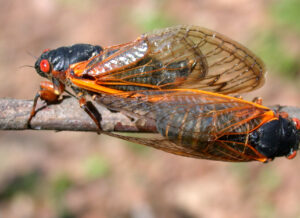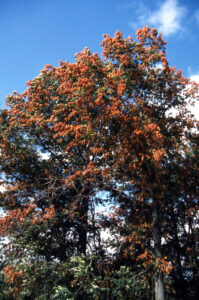When the irises begin to bloom, expect up to 1.5 million cicadas per acre to begin boiling out of the ground. This spring Indiana will see the emergence of the 17-year cicadas (Brood X). These insects feed underground for most of their lives drinking sap from tree roots. Once every 17 years they emerge en masse, climb up trees, sing (though it sounds more like screaming), mate, and lay their eggs on the tips of tree branches. This cycle is completely natural and has a long history in written and oral records. Cicadas are not harmful to humans, provide a feast for wildlife, and mostly only cause cosmetic injury to trees. However, there are some trees that will need protection to survive.
Cicada Emergence Timing and Locations
Where can you find cicadas?
17-year cicadas can be found throughout Indiana but the biggest populations will be in southern Indiana. According to Cicada Mania, these cicadas were reported to be more abundant in the following areas during their last emergence in 2004: “Bloomington, Brookville, Clinton Falls, Dillsboro, Fishers, French Lick, Indianapolis, Lawrenceburg, Lexington, Martinsville, McCormick’s Creek State Park, Nashville, North Vernon, Skiles Test Park, Spencer”
Cicadas need to feed on trees nearly constantly for most of their lives. They are therefore typically only found in areas that had trees 17 years ago and have continued to have trees since then. For example, an area that was forest 17 years ago but was cleared for farmland 10 years ago will not have a cicada emergence because the cicadas had no tree roots to feed on for the past 7 years. An area that was farmland 17 years ago and was recently planted with trees will also not have a cicada emergence because there were no trees on which the cicadas laid their eggs. However, a forested area or a city park that has had trees constantly for the last 17 years has a high chance of having a cicada emergence this spring.
When will 17-year cicadas emerge?
Timing of the 17-year cicada emergence depends on temperature. We can therefore expect them to emerge from the southern part of the state several weeks before they emerge in the north. The weather can also have an impact on emergence. For example, a warm spring might make them emerge sooner while a cold spring will delay the emergence. However, in most places the major emergences are expected to start in mid-April and continue through mid-May. A good rule of thumb is to expect the cicadas to emerge around the same time as irises start to bloom. You can also use the emergence calculator to estimate when they will come out in your area.
Cicada Visual ID

17-year cicadas have much brighter colors than their annual cousins. They can be recognized by their bright red eyes, black bodies, and orange wing veins. Image by John Obermeyer, Purdue Entomology, Purdue University.
What do cicadas look like?
Cicadas tend to have sturdy, thick bodies with mostly clear wings that are longer than their bodies. 17-year cicadas are distinctive from the annual cicadas in that their bodies are a dark, nearly black brown with amber highlights on their wing veins, and red eyes (figure 1). Check out this video to see the full life cycle and hear what a chorus of cicadas sounds like!
How many species of cicadas are there in Indiana?
There are more than you’d think! There are three main species of 17-year cicada in Indiana and about 16 species of annual and 13-year cicadas. You can find a full list here.

An example of a heavily damaged full grown tree. The brown, dead leaves are twigs that were killed by cicada egg laying. The damage may look severe, but this tree should recover from the cicada damage by the following year. Image by John Obermeyer, Purdue Entomology, Purdue University.
Cicada Damage and Control
What do cicadas prefer to eat?
17-year cicadas aren’t picky! They’ll feed on more than 270 species of woody plants. They show a slight preference for deciduous trees like maple, fruit trees, oak, and dogwood, but will generally feed on any deciduous tree or bush available to them.
How do cicadas injure plants?
Cicadas lay eggs by stabbing their ovipositor into tree bark. This can create scars in the bark. If enough cicadas lay eggs on a small branch, it can kill the twig. As a result, large trees sometimes have minor dieback at the ends of branches but overall tree health isn’t affected (figure 2). Small or young trees and shrubs, however, may be more seriously harmed.
What kind of plants should be protected from cicadas?
Cicada females prefer to lay their eggs in branches that are about 3/16 to 1/2 inch in diameter. Therefore, young deciduous trees or bushes that have major branches less than ½ inches in diameter should be protected in areas with high numbers of cicadas emerging. Mature trees do not require protection.
How should I protect my trees from cicadas?

All vulnerable parts of trees should be completely covered. Note how the branches are fully covered by the fine netting and the fabric is tied tightly at the trunk of the tree. Photo by James B Hanson USDA Forest Service.
Homeowners:
Homeowners only need to worry if they have newly planted trees (3-4 years old). The best way to protect these young trees is to cover them in a mesh fabric for the ~1 month period when the cicadas are active in the area. The mesh bags can be made from a variety of materials as long as the holes are smaller than 1 cm (~3/8 inch). Drape the fabric over all the twigs and branches that are smaller than 3/8 inches and secure it at the bottom so that cicadas cannot climb up from underneath (figure 3). The goal is to prevent the cicadas from having access to the branches so that they will lay their eggs elsewhere.
Larger trees do not need to be protected from cicadas. They may experience minor dieback at the tips of branches, but this will not harm the overall health of the tree. If you find these dead twigs unsightly, you can either trim them off or hire an arborist to remove them.
Fruit Growers and Nurseries:
We recommend netting over insecticides. Netting reduces injury by over 95%, while insecticides only reduce injury by 75%. Also, the insecticides that work best against cicadas are likely to kill helpful insects and cause problems with spider mites later in the season. Netting will keep the cicadas off of the trees without running the chance of the negative side effects of insecticides. However, we recognize that for large plantings netting isn’t practical. In these cases, pyrethroid insecticides will need to be applied repeatedly to trees during the ~1 month period when cicadas are active. Make sure to carefully read the labels before using them.
Learn more
The best way to keep up to date about this spring’s cicada emergence is to either sign up for our Cicada Newsletter or follow Purdue Entomology on Twitter or Facebook. We will share updates about the emergence timeline, any updates to management recommendations, community science programs, crafts for kids, and more. If you have any questions, please feel free to reach out to the authors!
Cover image by Dan Keck from flickr